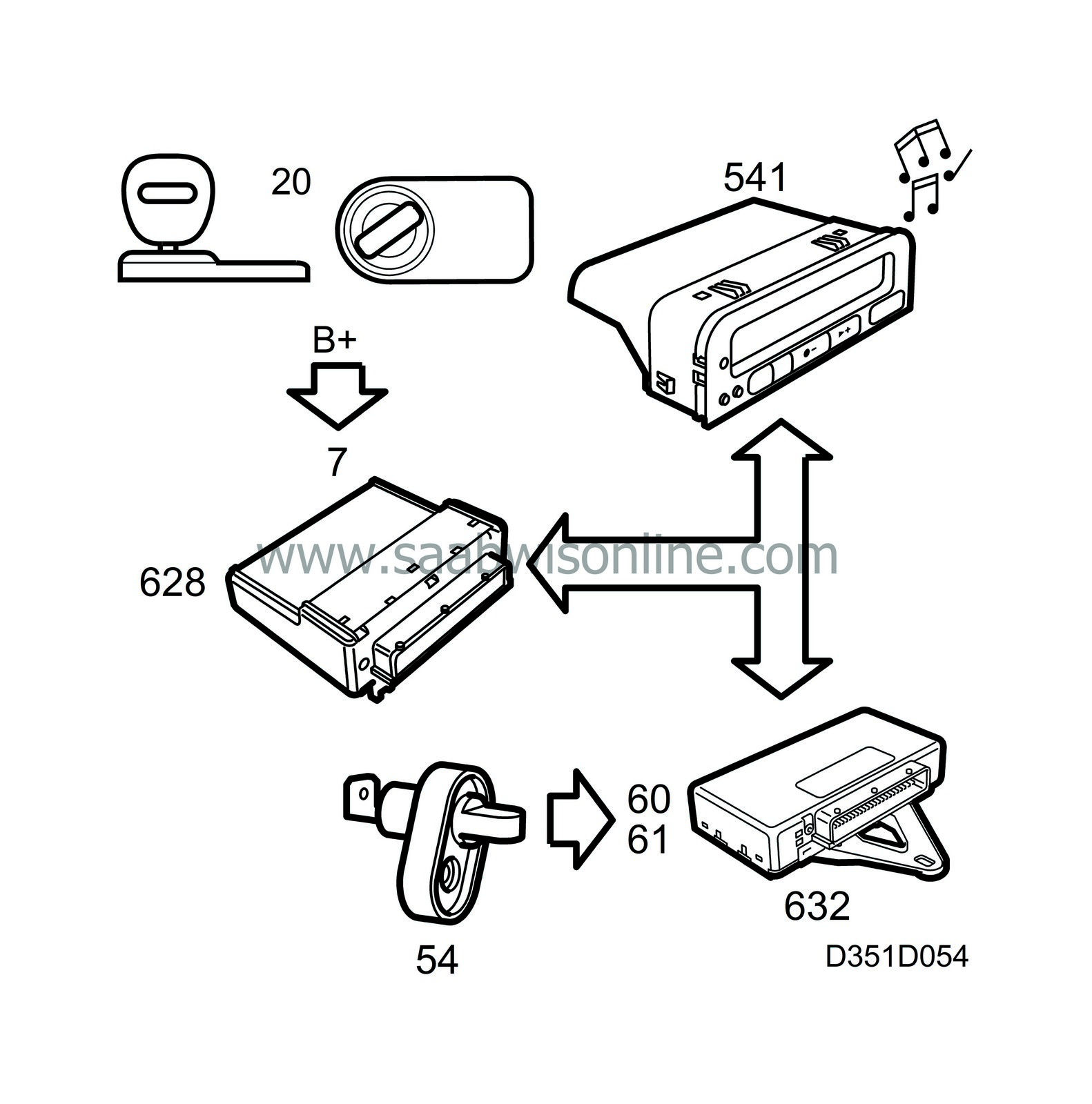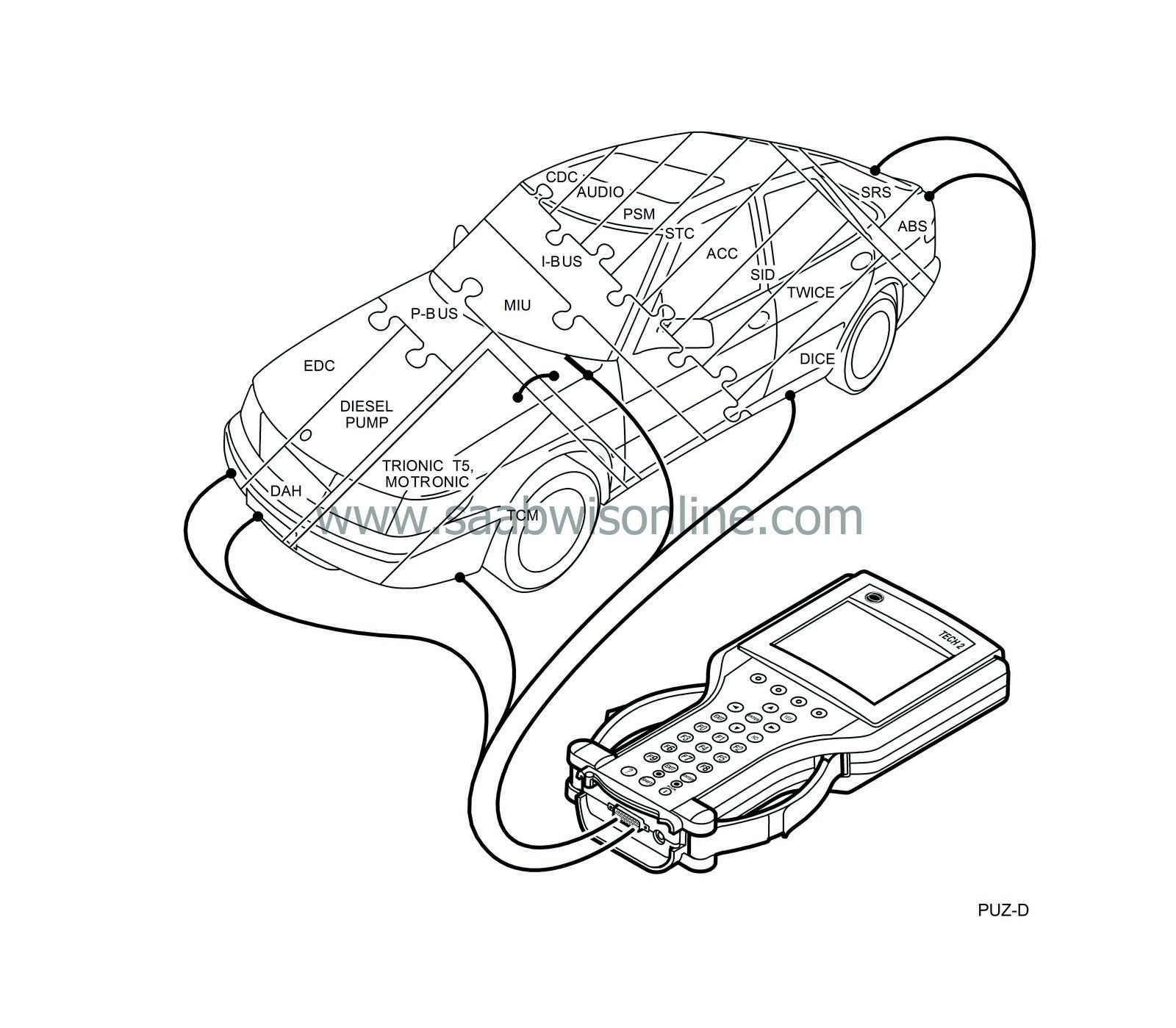Brief description
| Brief description |
| • |
Main lighting
|
|
| • |
Brake lights
|
|
| • |
Reversing lights
|
|
| • |
Front fog lights
|
|
| • |
Rear fog light
|
|
| • |
Direction indicators
|
|
| • |
Hazard flashers
|
|
The main lighting is controlled by the light switch on the dashboard and the dipswitch by the steering wheel. The other lamps in the exterior lighting system are controlled by separate switches.
Main lighting
The main and dipped beams, rear lights, number plate lighting, and parking lights are included in the main lighting. The light switch must be in position 2 and the ignition ON to operate the main lighting. The main and dipped beams are controlled by DICE via 2 relays. The parking lights are monitored by TWICE (like a filament monitor).The functions of the light switch in the car are controlled by the control module DICE. There are 3 different program alternatives for DICE that can be selected to suit the car market destination.
On certain markets, the dipped beam is used as daylight driving lights. The light switch must then be in position 0.
The parking lights are on when the light switch is in position 1, if the ignition is OFF. Depending on the current program alternative, the parking lights can be on when the light switch is in another position. In certain markets, the dipped beam is used as daylight driving lights.
The main and dipped beam function is monitored by a filament monitor. In the event of a fault, SID (Saab Information Display) will produce an acoustic alarm signal and display FRONT LIGHT FAILURE.
The rear lights (LH and RH) are monitored by TWICE. In the event of a fault in the rear light function, SID will produce an acoustic alarm signal and display REAR LIGHT FAILURE.
Brake lights
The brake lights are located in the rear lights and in a high-level brake light. The light source in the high-level unit consists of a number of LEDs (Light Emitting Diodes). When the brake pedal is depressed, a switch in the brake light circuit closes and the brake lights go on.The circuits to the brake lights are monitored by TWICE and an error message is sent to the bus if the current in the circuit drops below a certain value. In the event of a fault in the circuit, SID produces an acoustic alarm signal and displays BRAKE LIGHT FAILURE.
Reversing lights
The reversing lights are turned on by the reversing-light switch when reverse gear is engaged. DICE outputs the status of the reversing-light switch (ON/OFF) to the bus.Front fog lights
The front fog lights (certain markets) are located in the spoiler and operated by a switch on the dashboard when the light switch is in the position 1 or 2 (depending on market). The function can be programmed.Rear fog light
The rear fog light is on the right-hand side on right-hand drive cars or on the left-hand side on left-hand drive cars. The light is operated by a switch to the right of the light switch. The function is reset when the ignition is turned OFF. This means that the function must be reactivated next time the car is started.The circuits to the rear fog light are monitored by DICE and an error message is sent to the bus if the current in the circuit drops below a certain value. In the event of a fault, SID produces an acoustic alarm signal and displays FOG LIGHT FAILURE.
Direction indicators
When the direction indicators are activated, DICE sends a message to SID to produce an acoustic signal and to MIU (main instrument unit) to display a lamp signal. The flashing frequency is 90 flashes per second. When a lamp has failed the flashing frequency is doubled to 180 flashes per second.Hazard flashers
The hazard function turns on all the direction indicators with the hazard flasher switch. The flashing frequency is normally 90 flashes per second.| Important | ||
|
When changing a bulb, use one with the right output otherwise the components could be damaged. |
||
| Interior lighting |

The car's interior lighting comprises the following functions:
| • |
Interior lighting
|
|
| • |
Reading lights
|
|
| • |
Vanity mirror lighting
|
|
| • |
Glove box light
|
|
| • |
Luggage compartment lighting
|
|
| • |
Lighting for buttons and controls
|
|
The car's interior lighting is controlled by a number of switches inside the car.
Interior lighting
The interior lighting in the car is turned on and off automatically or manually, depending the position of the switch on the roof console. The switch has the following positions:1 - Interior lighting on.
0 - Automatic control on/off
2 - Interior lighting off.
DICE, which controls the power supply to the lamps, receives information about the status of the doors (OPEN/CLOSED) via the bus from TWICE.
Reading and mirror lighting
There are two reading lights in the front roof console and two rear lights located in the roof.The vanity mirror lighting is in the roof behind the sun visor beside each vanity mirror.
The lights are turned on and off with switches by the lamps.
Glove box light
The glove box lighting is turned on and off automatically when the glove box is opened and closed.Luggage compartment lighting
The light in the luggage compartment is on the left-hand side. It is turned on and off by a separate switch located on the lamp.DICE, which controls the power supply to the light, receives information about the status of the compartment lid (OPEN/CLOSED) via the bus from TWICE.
Lighting for buttons and controls
The light intensity is controlled by DICE. The intensity can be adjusted manually by a rheostat control (potentiometer). Information from the rheostat (0-100%) is sent via the bus. DICE measures the lamp voltage and uses pulse width modulation (PWM) to control the light intensity.| Important | ||
|
All lamp outlets are protected from short circuiting. |
||
|
Do not change to bulbs with a higher output as the outlets will not withstand overloading. |
||
|
If the output is too high, the short circuiting protection is broken immediately. |
||
| Signal system |

Light and ignition key warnings
An acoustic warning signal is activated if the main lights are on when the driver's door is open and the parking lights are on and the key has been removed from the ignition switch.An acoustic warning signal is activated if the key is still in the ignition switch when the driver's door is open and the ignition switch is in the LOCK or OFF position.
If the driver's door is opened, DICE receives information via the bus from TWICE (OPEN/CLOSED). DICE sends information via the bus to SID (ACOUSTIC SIGNAL) and a PLING sound is heard. The maximum duration of the acoustic signal is 10 minutes.

Horn
Two horns of the trumpet type are located behind the grille under the radiator cross-member. The horn switch is located in the centre of the steering wheel.The horns are tuned to different frequencies. The horn marked H is high frequency and the one marked L is low frequency.
The horn is also used for confirmation of “TSL”-locking (Theft Security Lock) of the car. The SID unit receives information via the bus from TWICE and the horn is activated.
| P-bus and I-bus |

In the Saab 9-3 car, there are not so many control modules connected to the bus systems, compared with the Saab 9-5.
The two power-train systems, EDC and the diesel pump, are however not connected to the I-bus (Instrument Bus). These systems require considerably faster communication so that no delays are noticeable, for example, when the EDC requests a certain fuel mass for injection.
Therefore, they are connected to a separate bus called the P-bus (Power-train Bus). The data transfer rate on the P-bus is ten times faster than on the I-bus.
The P-bus is also connected to the MIU (Main Instrument Unit). The MIU is responsible for ensuring that the information available on the one bus is also available on the other bus.



